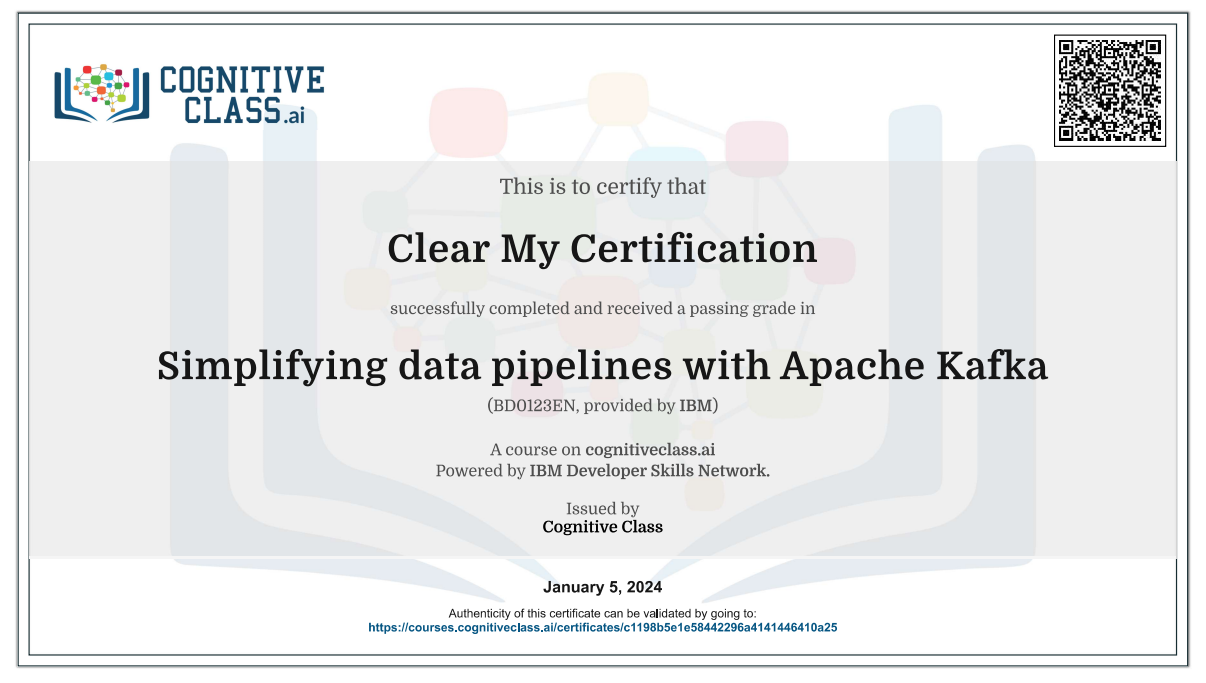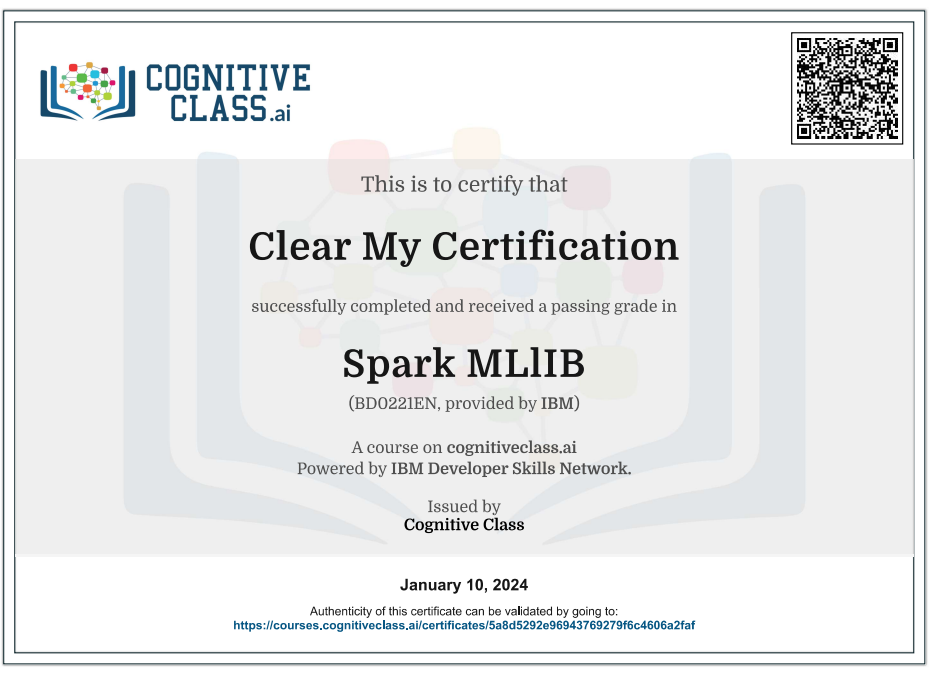Enroll Here: Simplifying data pipelines with Apache Kafka Cognitive Class Exam Quiz Answers
Simplifying data pipelines with Apache Kafka Cognitive Class Certification Answers

Modules 1 – Introduction to Apache Kafka Quiz Answers – Cognitive Class
Question 1: Which of the following are a Kafka use case?
- Messaging
- All of the above
- Stream Processing
- Website Activity Tracking
- Log Aggregation
Question 2: A Kafka cluster is comprised of one or more servers which are called “producers”
- True
- False
Question 3: Kafka requires Apache ZooKeeper
- True
- False
Modules 2 – Kafka Command Line Quiz Answers – Cognitive Class
Question 1: There are two ways to create a topic in Kafka, by enabling the auto.create.topics.enable property and by using the kafka-topics.sh script.
- True
- False
Question 2: Which of the following is NOT returned when –describe is passed to kafka-topics.sh?
- Configs
- None of the Above
- PartitionNumber
- ReplicationFactor
- Topic
Question 3: Topic deletion is disabled by default.
- True
- False
Module 3 – Kafka Producer Java API Quiz Answers – Cognitive Class
Question 1: The setting of ack that provides the strongest guarantee is ack=1
- True
- False
Question 2: The KafkaProducer is the client that publishes records to the Kafka cluster.
- True
- False
Question 3: Which of the following is not a Producer configuration setting?
- batch.size
- linger.ms
- key.serializer
- retries
- None of the above
Module 4 – Kafka Consumer Java API Quiz Answers – Cognitive Class
Question 1: The Kafka consumer handles various things behind the scenes, such as:
- Failures of servers in the Kafka cluster
- Adapts as partitions of data it fetches migrates within the cluster
- Data management and storage into databases
- a) and b) only
- All of the Above
Question 2: If enable.auto.commit is set to false, then committing offsets is done manually, which provides gives you more control.
- True
- False
Question 3: Rebalancing is a process where group of consumer instances within a consumer group, coordinate to own mutally shared sets of partitions of topics that the groups are subscribed to.
- True
- False
Module 5 – Kafka Connect and Spark Streaming Quiz Answers – Cognitive Class
Question 1: Which of the following are Kafka Connect features?
- A common framework for Kafka connectors
- Automatic offset management
- REST interface
- Streaming/batch integration
- All of the above
Question 2: Kafka Connector has two types of worker nodes called standalone mode and centralized mode cluster
- True
- False
Question 3: Spark periodically queries Kafka to get the latest offsets in each topic and partition that it is interested in consuming form.
- True
- False
Simplifying Data Pipelines with Apache Kafka Final Exam Answers – Cognitive Class
Question 1: If the auto.create.topics.enable property is set to false and you try to write a topic that doesn’t yet exist, a new topic will be created.
- True
- False
Question 2: Which of the following is false about Kafka Connect?
- Kafka Connect makes building and managing stream data pipelines easier
- Kafka Connect simplifies adoption of connectors for stream data integration
- It is a framework for small scale, asynchronous stream data integration
- None of the above
Question 3: Kafka comes packaged with a command line client that you can use as a producer.
- True
- False
Question 4: Kafka Connect worker processes work autonomously to distribute work and provide scalability with fault tolerance to the system.
- True
- False
Question 5: What are the three Spark/Kafka direct approach benefits? (Place the answers in alphabetical order.)
Question 6: Kafka Consumer is thread safe, as it can give each thread its own consumer instance
- True
- False
Question 7: What other open-source producers can be used to code producer logic?
- Java
- Python
- C++
- All of the above
Question 8: If you set acks=1 in a Producer, it means that the leader will write the received message to the local log and respond after waiting for full acknowledgement from all of its followers.
- True
- False
Question 9: Kafka has a cluster-centric design which offers strong durability and fault-tolerance guarantees.
- True
- False
Question 10: Which of the following values of ack will not wait for any acknowledgement from the server?
- all
- 0
- 1
- -1
Question 11: A Kafka cluster is comprised of one or more servers which are called “Producers”
- True
- False
Question 12: What are In Sync Replicas?
- They are a set of replicas that are not active and are delayed behind the leader
- They are a set of replicas that are not active and are fully caught up with the leader
- They are a set of replicas that are alive and are fully caught up with the leader
- They are a set of replicas that are alive and are delayed behind the leader
Question 13: In many use cases, you see Kafka used to feed streaming data into Spark Streaming
- True
- False
Question 14: All Kafka Connect sources and sinks map to united streams of records
- True
- False
Question 15: Which is false about the Kafka Producer send method?
- The send method returns a Future for the Record Metadata that will be assigned to a record
- All writes are asynchronous by default
- It is not possible to make asynchronous writes
- Method returns immediately once record has been stored in buffer of records waiting to be sent
Introduction to Simplifying data pipelines with Apache Kafka
Apache Kafka is a distributed streaming platform that can simplify and streamline data pipelines by providing a scalable, fault-tolerant, and highly available infrastructure for handling real-time data feeds. Kafka is particularly effective for building event-driven architectures and simplifying the process of ingesting, processing, and delivering data across various components of a system. Here are ways in which Apache Kafka can simplify data pipelines:
1. Decoupling Producers and Consumers:
- Kafka acts as an intermediary between data producers and consumers. Producers publish data to Kafka topics without knowing who the consumers are, and consumers subscribe to topics without knowing the identity of the producers. This decoupling allows for more flexible and scalable architectures.
2. Scalability:
- Kafka is designed to scale horizontally, allowing you to handle increasing data volumes by adding more Kafka brokers to the cluster. This scalability is crucial for accommodating the growth of data pipelines.
3. Fault Tolerance:
- Kafka ensures fault tolerance by replicating data across multiple brokers. In case of a broker failure, the system can continue to operate without data loss. This resilience is essential for maintaining data integrity and availability in data pipelines.
4. Real-time Data Streaming:
- Kafka supports real-time data streaming, enabling the ingestion and processing of data in near real-time. This is beneficial for applications that require low-latency and timely data delivery.
5. Durability and Persistence:
- Kafka retains data for a configurable retention period, providing durability and persistence. This allows consumers to replay events or recover from failures by retrieving data from the Kafka logs.
6. Event Sourcing:
- Kafka can be used as an event sourcing mechanism, capturing and storing all changes to an application’s state as a sequence of events. This simplifies the implementation of event-driven architectures and helps maintain a reliable audit trail.
7. Integration with Ecosystem:
- Kafka integrates seamlessly with various data processing frameworks and storage systems. This includes Apache Flink, Apache Spark, Elasticsearch, and others, allowing for a diverse and extensible ecosystem.
8. Schema Registry:
- Kafka provides a Schema Registry that helps manage the schema evolution of data over time. This is especially useful when dealing with evolving data structures in a distributed system.
9. Data Transformation and Enrichment:
- Kafka can be used to transform and enrich data in-flight using Kafka Streams or other stream processing frameworks. This simplifies the process of data transformation and reduces the need for multiple processing steps.
In summary, Apache Kafka simplifies data pipelines by providing a robust, scalable, and flexible foundation for building real-time data streaming applications. Its capabilities, including decoupling, scalability, fault tolerance, and integration with various components, make it a powerful tool for simplifying complex data processing workflows.
 Clear My Certification All Certification Exam Answers
Clear My Certification All Certification Exam Answers



